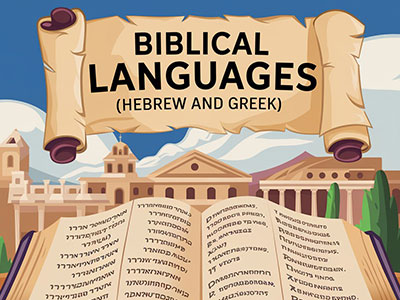Biblical Languages (Hebrew and Greek)
This course provides a foundational introduction to Biblical Hebrew and Greek, the original languages of the Old and New Testaments. Participants will learn essential grammar, syntax, and vocabulary, enabling them to read and translate simple biblical texts. The program integrates …
Overview
This course provides a foundational introduction to Biblical Hebrew and Greek, the original languages of the Old and New Testaments. Participants will learn essential grammar, syntax, and vocabulary, enabling them to read and translate simple biblical texts. The program integrates practical translation exercises, reading comprehension, and the use of lexical aids and scholarly commentaries to deepen scriptural understanding.
Course Objectives
By the end of this course, participants will be able to:
- Identify and write the Hebrew and Greek alphabets, mastering their pronunciation and vowel systems.
- Understand and apply basic grammatical rules, including noun cases, verb conjugations, and sentence structures in both languages.
- Develop a foundational vocabulary for translating common biblical texts.
- Translate selected passages from the Hebrew Bible and New Testament, focusing on narrative and poetic styles.
- Utilize lexicons and commentaries to enhance translation accuracy and comprehension of complex grammatical constructs.
Certification
Upon successful completion, participants will be awarded a Certificate in Biblical Languages (Hebrew and Greek). This certification demonstrates proficiency in advanced interpretive methodologies, readiness for teaching and preaching ministries, and a strong foundation for theological research or pastoral applications.
Learning Outcomes
Upon successful completion of the course, participants will:
- Demonstrate proficiency in reading and writing the Hebrew and Greek alphabets.
- Translate and analyze simple biblical texts, such as Genesis 1, Psalm 23, and selected New Testament passages.
- Interpret the grammatical and syntactical features of biblical texts, including subordinate clauses, imperative moods, and poetic structures.
- Apply vocabulary and grammar knowledge to identify and parse verbs, nouns, and phrases in context.
- Effectively use lexicons and commentaries to explore the historical, theological, and cultural dimensions of biblical texts.
Curriculum
Curriculum
- 3 Sections
- 12 Lessons
- 10 Weeks
- Module 1: Introduction to Biblical HebrewThis module introduces students to the basics of Biblical Hebrew, focusing on the alphabet, vowels, and essential grammar needed to begin translating simple biblical passages. Topics covered in this module include: Hebrew Alphabet and Vowels, Basic Grammar, Introduction to Verbs, and Reading Simple Biblical Texts4
- Module 2: Introduction to Biblical GreekThis module covers the fundamentals of Koine Greek, the dialect in which the New Testament was written, focusing on the alphabet, basic syntax, and key grammatical concepts. Topics covered in this module include: Greek Alphabet and Pronunciation, Basic Grammar, Introduction to Verbs, and Reading Simple New Testament Texts4
- Module 3: Integrating Reading SkillsThis module aims to reinforce and expand the reading skills acquired in Hebrew and Greek through increased exposure to biblical texts and more complex grammatical structures. Topics covered in this module include: Expanding Vocabulary, Complex Sentences and Grammar, Translating Psalms and Parables, and Use of Lexicons and Commentaries4




